Blogger Outreach: How to Do It Successfully in 2025 (Complete Guide)

You’ve built something great, and you want to spread the word about it.
While your family and friends already share posts on social media about your new launch, you want to go beyond and get even more visibility and relevant traffic.
You think blogger outreach would be the right thing to do. And you’re right!
Blogger outreach can look simple — you contact the right person with an appealing offer, they spread the word about you, and you get tons of new leads interested in your product or service.
The general idea sounds simple, but when you start working on your first blogger outreach campaign, you may encounter a lot of pitfalls and questions:
- How to find relevant prospects and their contact information
- How to craft your pitch to get attention
- How to scale and automate your outreach process
In this guide, we’ll walk you through all of these steps and show you how to set up the blogger outreach campaign that will help you get more visibility—new reviews, backlinks, social media shares, or whatever you want to achieve.
What is blogger outreach?
Blogger outreach is a form of influencer marketing where you reach out to influencers who have a huge follower base and persuade them to share your product or service with their audience.
The critical difference between blogger outreach and spam is that you have to take care of the list of those you want to contact.
You need to do in-depth research to make sure prospects are relevant to your niche and interested in your product or service.
Additionally, you have to collect as much information as possible about influencers and their audience to show how you can help them solve specific problems.
Blogger outreach is a process of contacting the right person with the right offer, where you both get benefits from it.
You can use blogger outreach for:
- Link building: You contact bloggers pitching your page and aiming to get a link on their website.
- Guest posts: You want to contribute a piece of content on the topic related to your and the blogger’s website.
- Product reviews: You share your product (early access, free version, etc.) with bloggers if you want them to try and review it.
- Interview requests: You want to interview opinion leaders in your industry to build authority in your niche and get new website visitors familiar with the influencer you interviewed.
- Building relationships: You want to build good relationships with industry leaders to use those connections later to spread the word about your product or service.
1. Identify suitable bloggers
The first step in the blogger outreach process is to find relevant influencers to reach out to. There are three key strategies that usually show the best results:
1. Use Google
This process is a bit time-consuming since you need to do a manual check, but it’s perfect for those who don’t have a big budget.
Start by generating a list of seed keywords related to your product or service. For example, for us at Hunter, it could be something like:
- Cold outreach
- Cold email
- Find email address
- Verify email address
- Check whether the email is opened
Next, search for each keyword on Google and check what kind of authority blogs rank for that keyword.
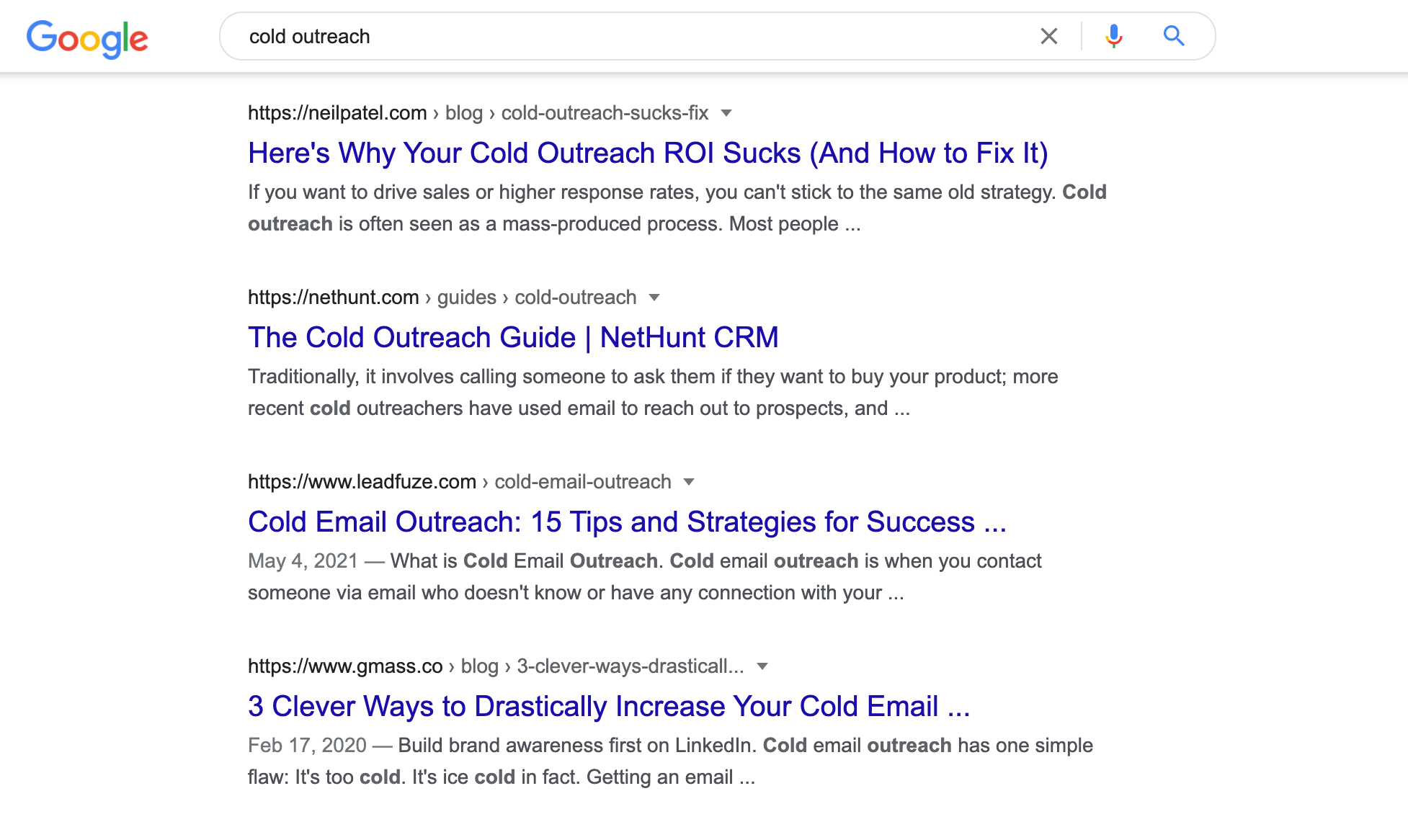
Do a quick check of each website to see whether they focus on covering topics related to your business. If they do, go and add these prospects to your list!
Pro tip: If you use Ahrefs SEO Toolbar, you’ll be able to quickly analyze the top-ranking search results, having in front of you a bunch of metrics that show the authority of the website, its traffic, link profile, etc. Also, it could simplify the export process. With Ahrefs SEO Toolbar, you’ll be able to export the top 100 Google search results in one click.
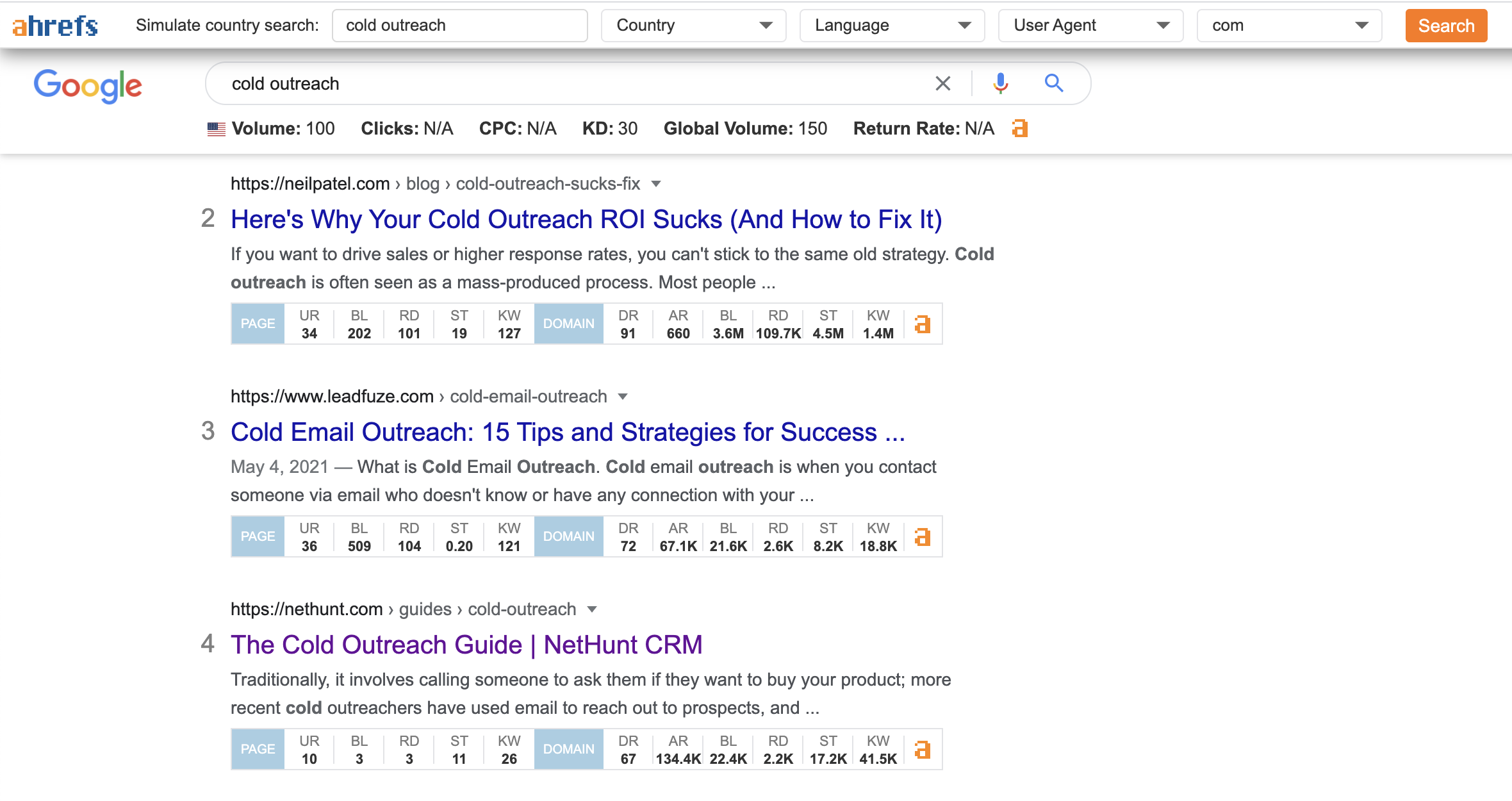
2. Find prospects with Ahrefs
Ahrefs has a bunch of tools that could simplify and automate the prospect lookup process. We use these two tools most often: Content Explorer and Site Explorer.
Find prospects with Content Explorer
Content Explorer is a vast database of over a billion web pages where you can search for pages applying filters related to your needs.
For example, if we search for the “find email address” keyword, we get 367,342 results. You can export them all in one click.
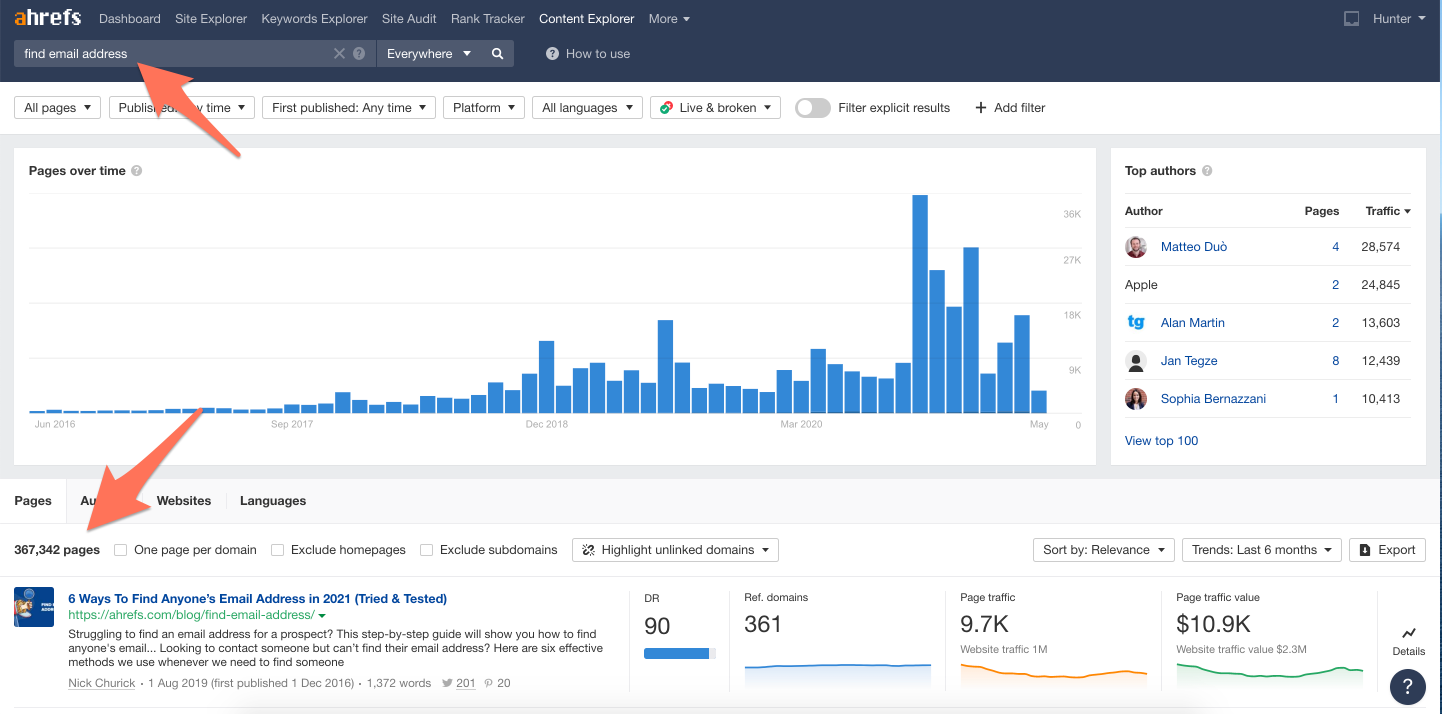
You can narrow down your search by applying filters such as:
- Languages – Useful for targeting websites that contain content in a specific language.
- First published – This will make sure you only see fresh content.
- One page per domain – To avoid pitching the same website more than once.
For example, by applying these three filters, we narrowed down the list to 132,612 pages. You can use as many filters as you want to get more specific results for your needs.

Find prospects with Site Explorer
With Site Explorer, you’ll be able to generate tons of prospects for outreach by scraping backlinks from pages related to your niche.
Choose one of the blog posts related to your niche you found with Content Explorer. For example, for Hunter, it could be this one: a guide on finding anyone’s email address created by Moz (it has links from 139 referring domains).

Type the link into Site Explorer and open the Backlinks report. You’ll find tons of relevant prospects there who are interested in your topic.
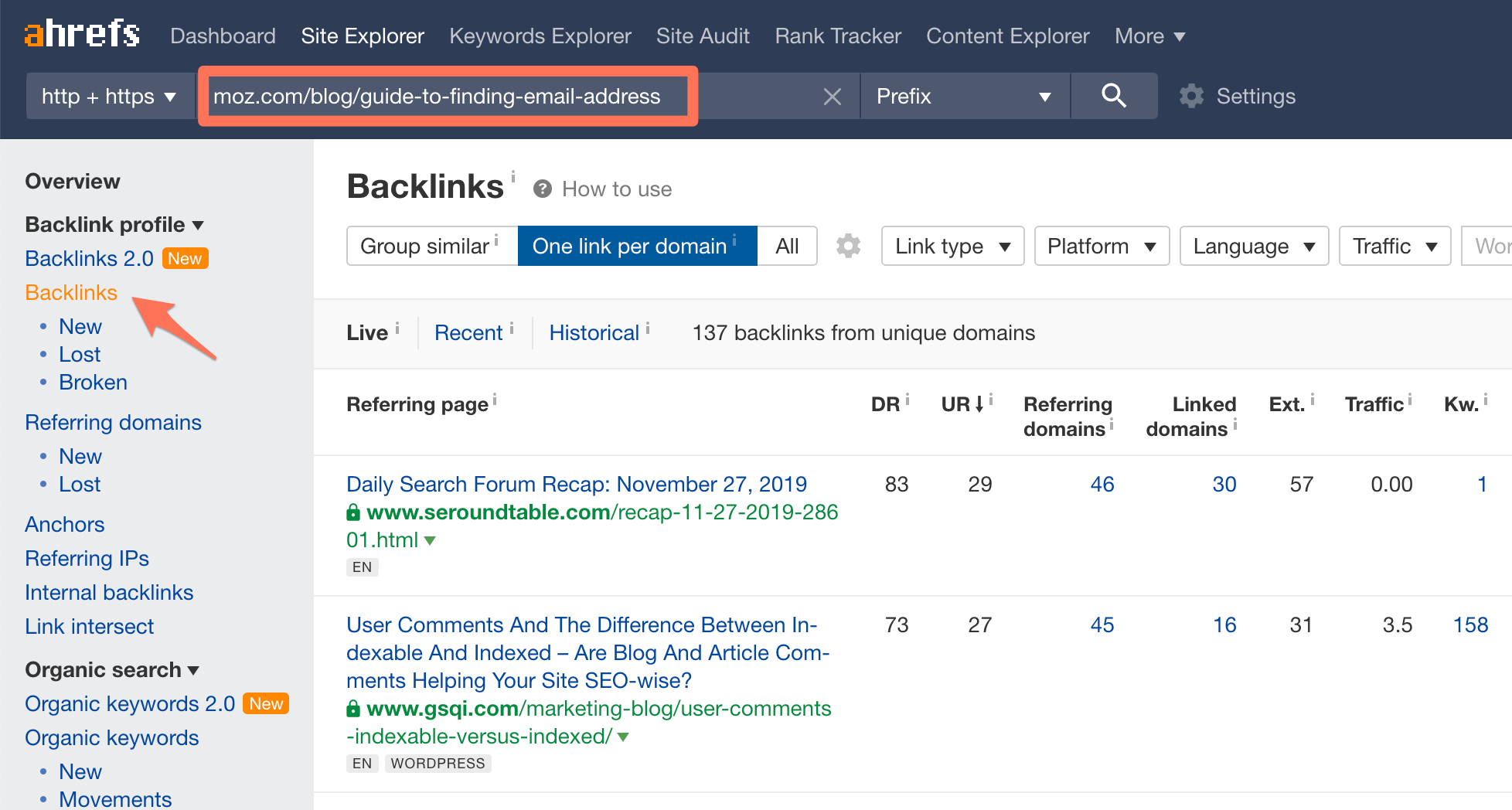
As for Content Explorer, you can apply multiple filters to narrow down the list of prospects.
3. Discover bloggers using BuzzSumo
BuzzSumo lets you find the best influencers to boost your company’s visibility. Its Influencer Tool allows you to track down the most influential authors, YouTubers, and Twitter users.
For example, you can find the most influential authors around your subject just by typing a seed keyword into the search box.
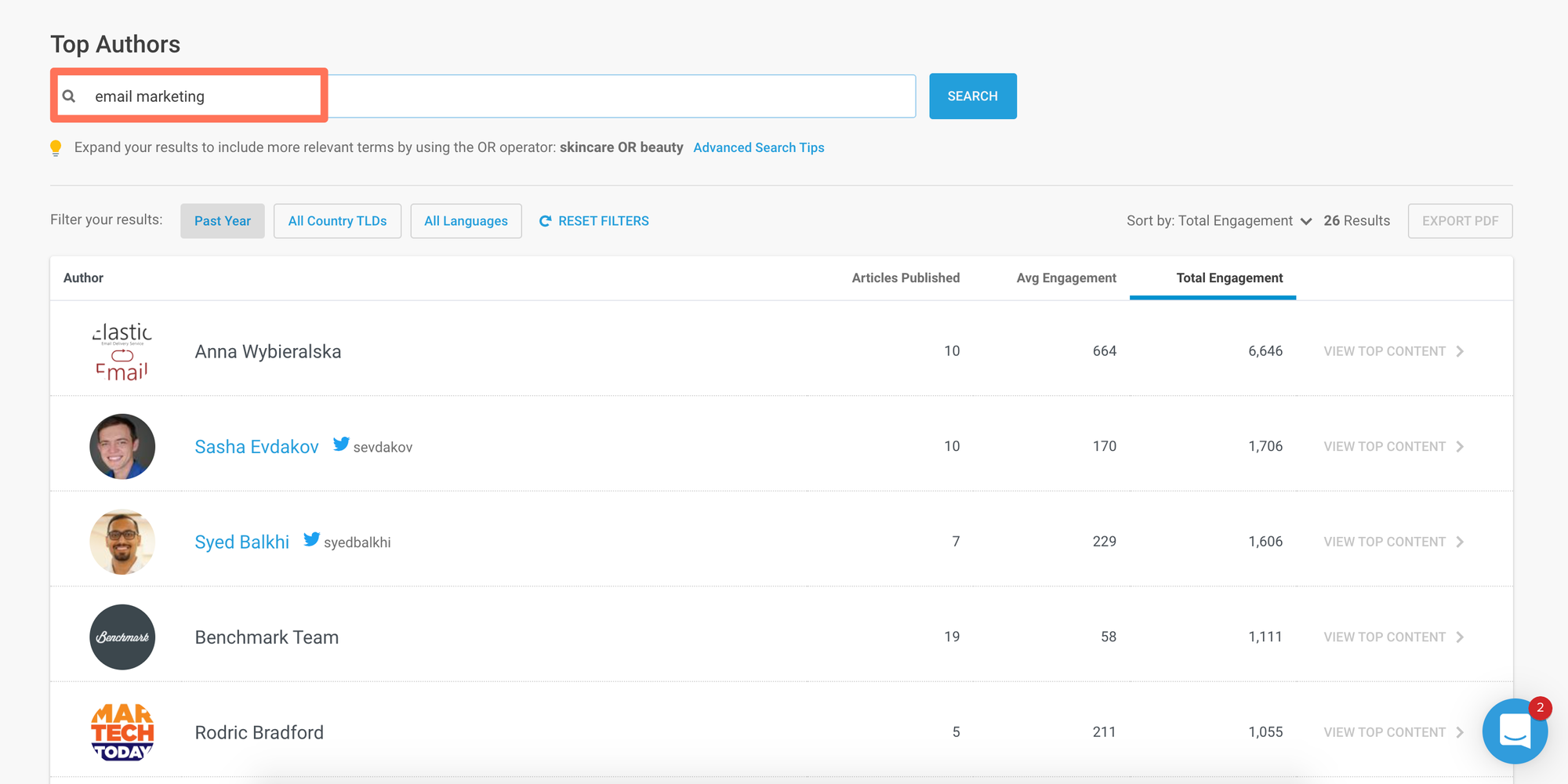
You can find the top headlines these authors have shared and sort them by the number of articles they’ve published on the same topic.
Besides that, you can check for influencers on Twitter, Facebook, and YouTube just by typing in your seed keyword and applying different filters (number of followers, page authority, retweet ratio, location, etc.).
You can save and export all of your searches for future outreach.

2. Find bloggers' contact information
Now, when you’ve found enough bloggers for outreach, it’s time to find their contact information.
To automate the contact lookup process, you can use one of the following tools depending on what kind of data you have:
Find article authors with Author Finder
Once you finish looking for the prospect with Google, Ahrefs, or BuzzSumo, you may end up with a list of articles your target bloggers have created.

To find the contact information of the authors of those blog posts, you can use Author Finder.
Simply paste the blog post URL into the search box, and you'll get the author's email address in seconds.
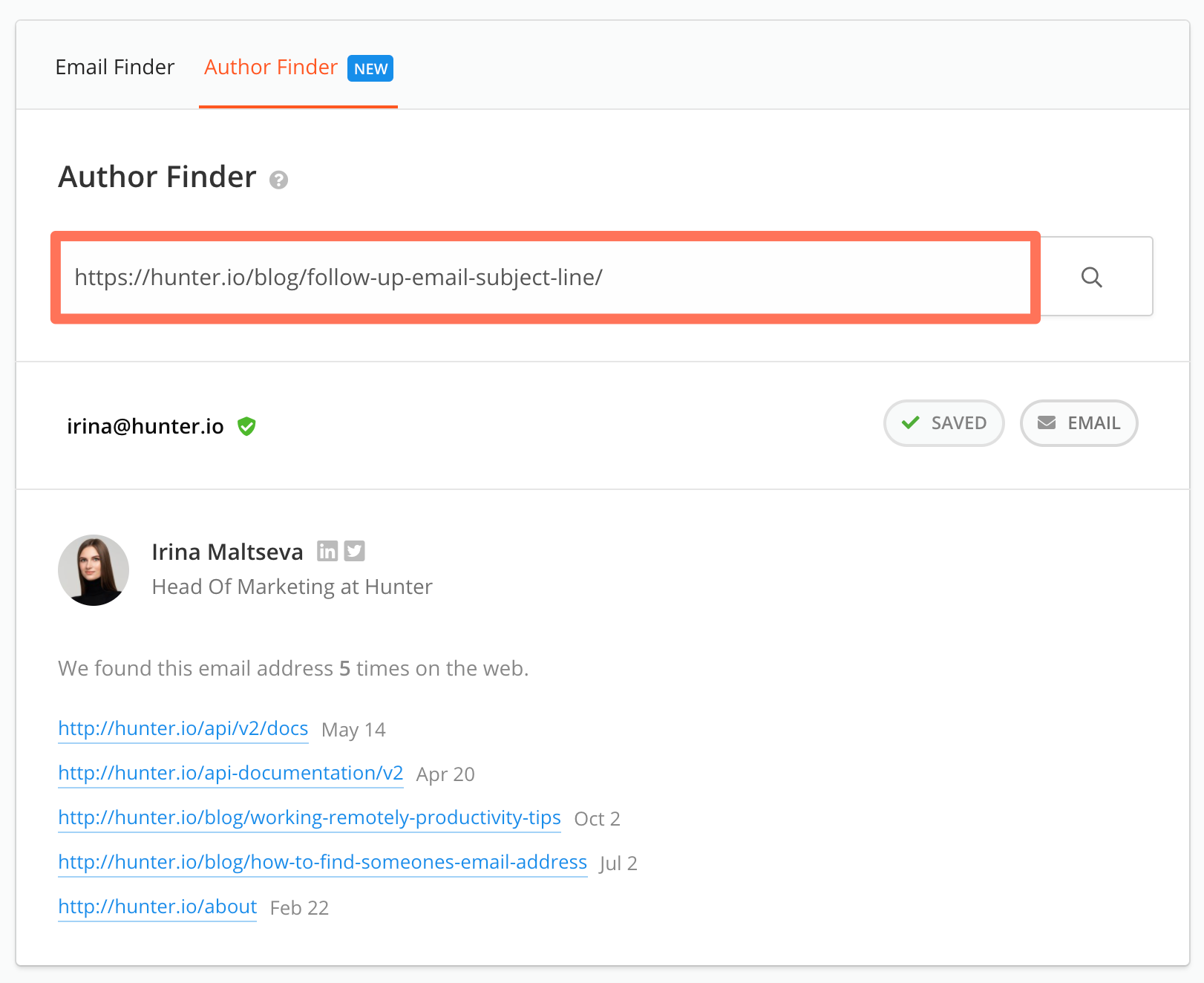
Along with the email address, you’ll also get the author’s full name, company, job title, and public sources where the email was mentioned.
You can save the email address as a lead in Hunter or send an email to the person right away by clicking the button with the email icon.
If you have a huge list of article URLs (and that could be the typical case for blogger outreach), you can automate the contact lookup process by using the Bulk Author Finder.
Simply paste the list of URLs you have or load the list from a file, and you’ll get all of the contact information with a click of a button.
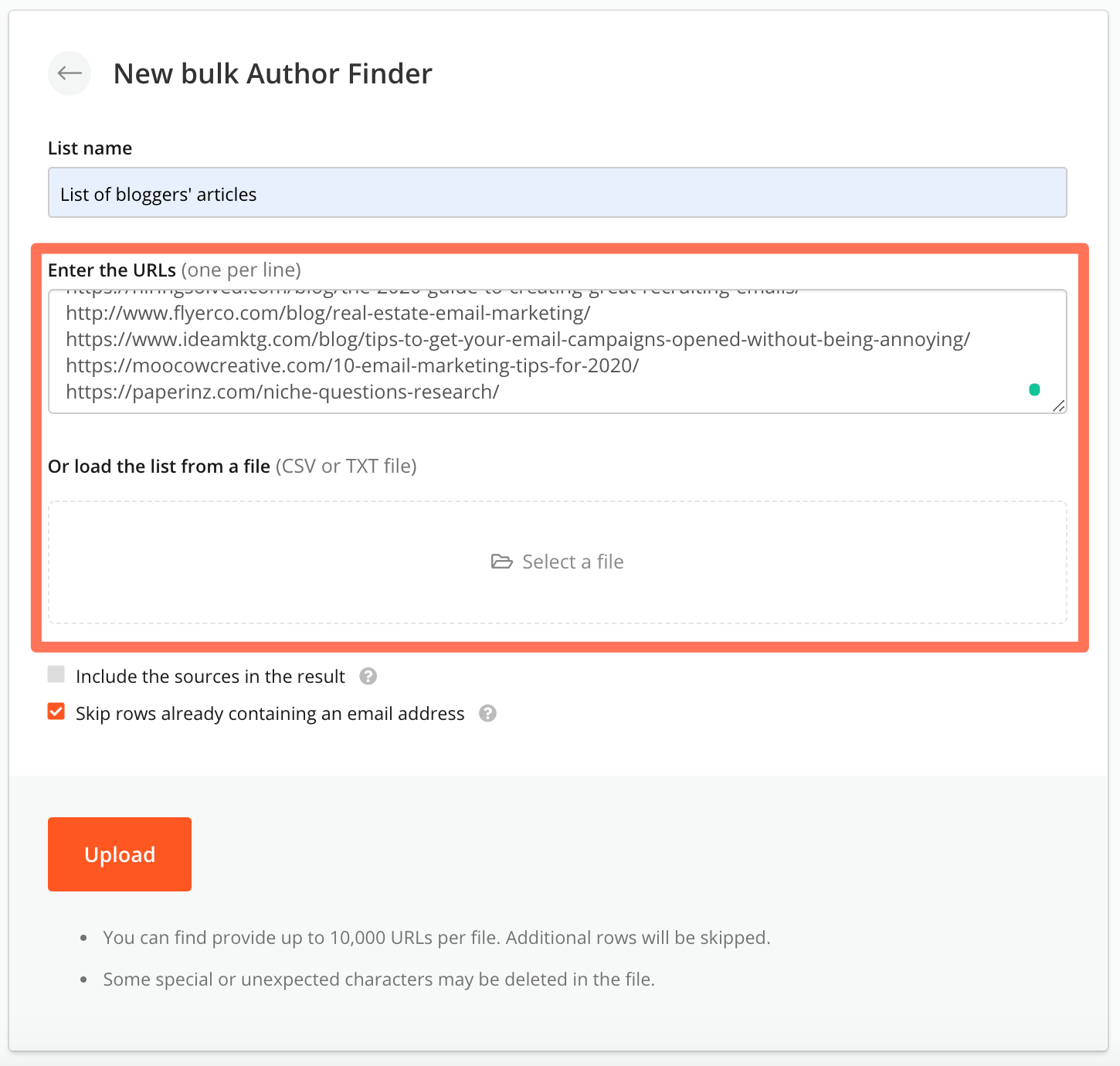
You can download the final result as a .CSV file.
Find specific prospects with Email Finder
You may find it helpful to automate the contact lookup process with Email Finder if you only know the prospect’s name and website.
Just enter the full name of your prospect into the search box along with the domain name, and you’ll get their email address in seconds.

If you have a massive list of prospect names and domains, you can import them all at once and find contact information with the Bulk Email Finder.
Here's how to do it:
Go to the Bulk Email Finder page and click on New bulk.
Add a name for your list and upload your list of prospects.
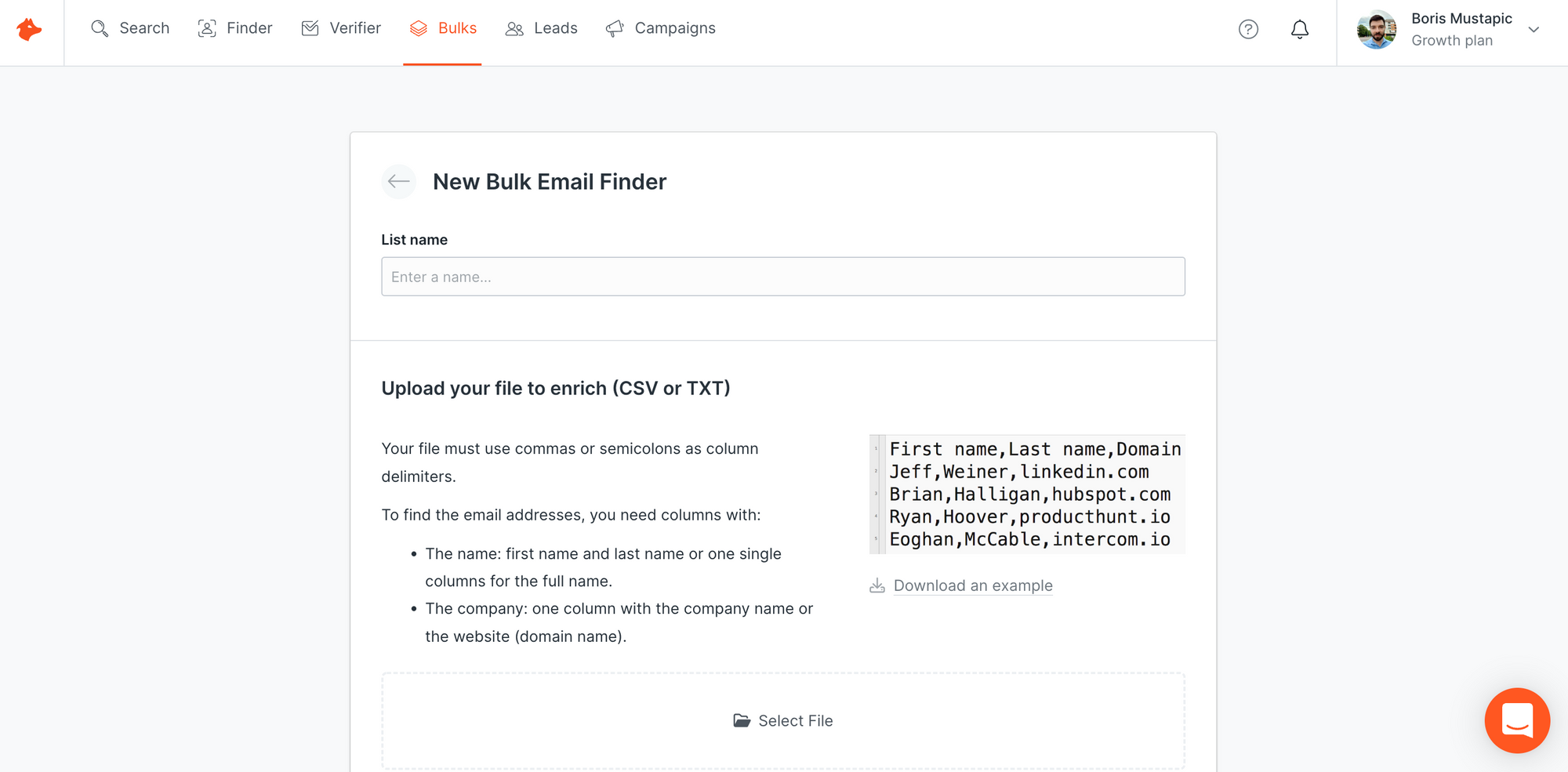
On the next page, make sure to match the columns with the appropriate fields.
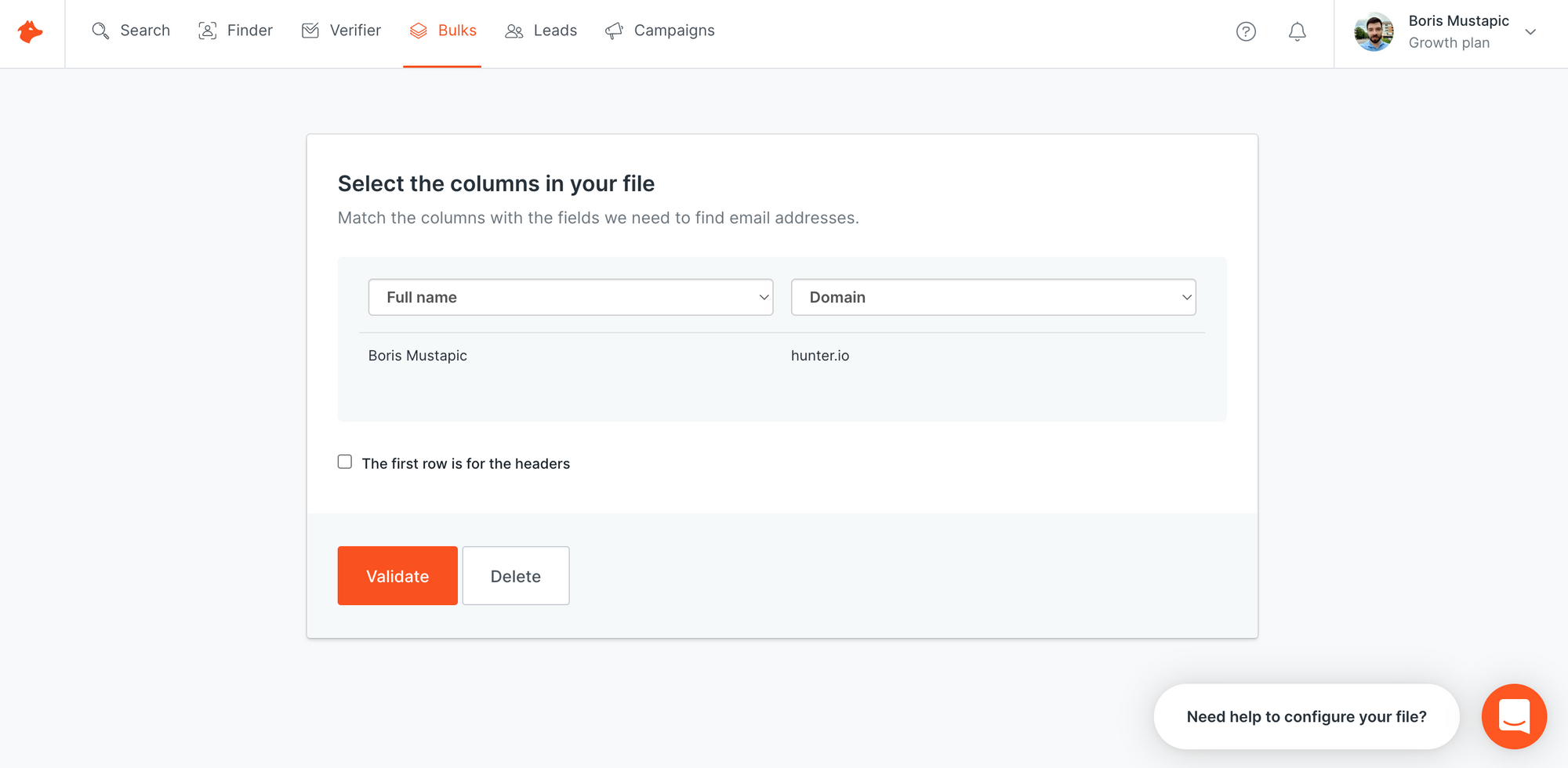
Finally, click on Validate. After a few moments, you'll get a list of the email addresses for the prospects you included in the list.
3. How to segment your list
You should personalize your pitch for every blogger if you want to get good results from your outreach.
This makes it essential that you segment your list into categories. These are three key segments you can start with:
Industry stars
These are people who are well-known in your industry. They are opinion leaders who are usually super busy, and the only chance to get on their radar is to get a personal introduction.
It’s super hard to catch their attention with a generic cold email. If you’d like to contact them, it’s best to find a mutual connection or send a very personal and relevant email to initiate a conversation.
Market influencers
The influencers from this segment are not as popular as industry stars. However, they are powerful enough to impact your business.
It could be influencers who run their businesses in a similar niche, have popular blogs, podcasts, or YouTube channels, and have tons of followers.
At the same time, they’re open to new partnerships and check their inboxes regularly for new business opportunities.
You can get their attention with a cold email. However, you’ll need to do in-depth research before reaching out and send personal and quite relevant offers to them.
Emerging bloggers
These are the smallest bloggers who are just starting a blog and are still new to the industry. They have some industry experience, but not many people are aware of them.
They don’t have thousands of followers but could be pretty influential in tight professional circles.
You can decide whether to contact them or not. It all depends on your business goals.
For example, they could be relevant to reach for link building. If you see that their blogs are growing and they constantly work on their content, a link with a small domain authority can become a powerful link very soon.
To contact these bloggers, you can collect some basic information on them, such as their industry, name, and interests, and run a cold outreach campaign with a tool like Hunter Campaigns.
How to segment bloggers into categories?
The easiest and fastest way to do it is to segment your list based on Ahrefs’ Domain Ranking (if you use Ahrefs to collect prospects, that is).
The Domain Rating (or DR) is the metric that shows the strength of a website’s backlink profile compared to others in the Ahrefs database on a scale of 1 to 100. This means that the higher the DR is, the more influential the blogger or website is.
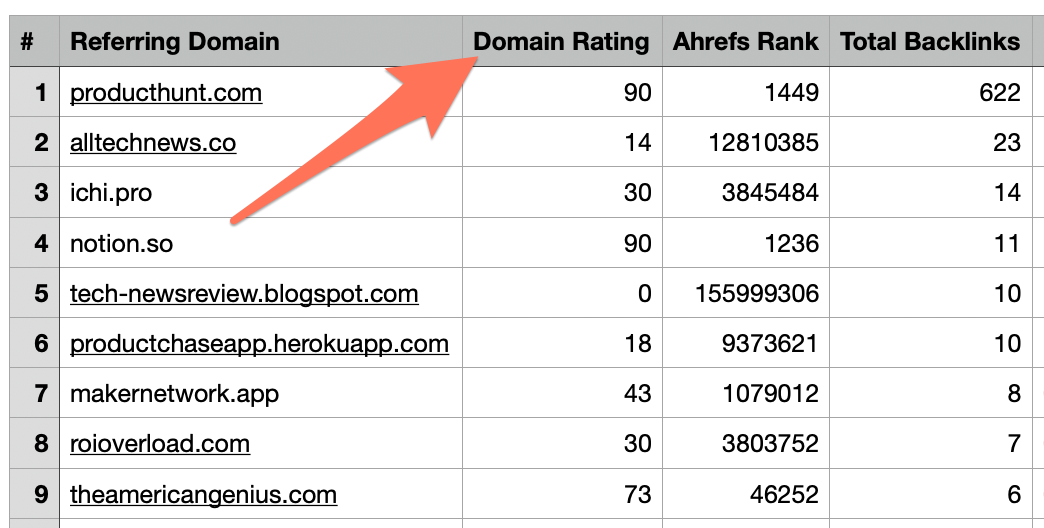
For example, to filter out the industry stars, remove prospects with a DR 80 or higher. To remove emerging bloggers, you can remove everyone with a DR lower than 40.
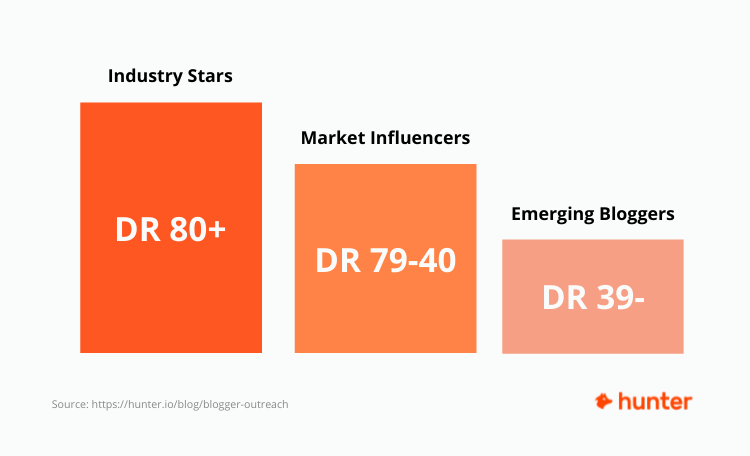
4. Approaches to outreach
There are two critical approaches for cold outreach: sniper and shotgun.
The sniper approach
The sniper approach is focused on sending highly personalized emails manually. You have to choose your targets carefully and find a unique approach for each prospect.
Here is an example of the sniper approach that I recently used:
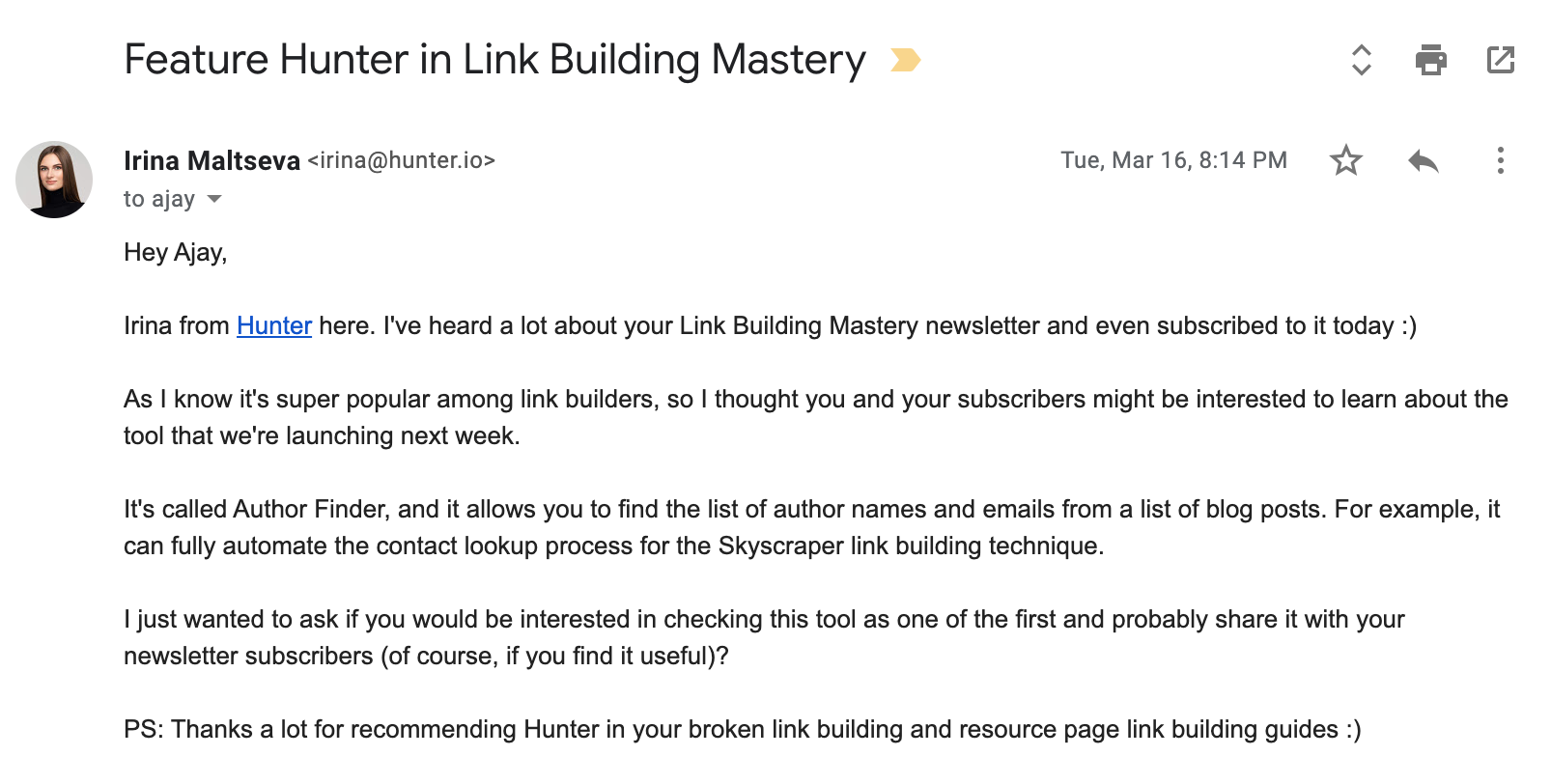
I used it to pitch Author Finder to one of the bloggers in the link building niche. As you see, this email is focused on Ajay only and couldn’t be applicable to any other blogger because of the personalization used.
Pros of the sniper approach
- You can use this approach to target famous bloggers (personalization is essential in this case).
- It's easier to build rapport with bloggers when you show them that you've done your research.
- The response rate is typically higher.
Cons of the sniper approach
- It’s time-consuming since you need to craft every email manually and send them out manually as well.
- You have to manage the whole follow-up process by yourself, and keep in mind when and who to follow up with.
The shotgun approach
The shotgun approach is much different from the sniper one since the former is focused on outreach automation. The idea of the correctly executed shotgun approach is to stay personal while automating the whole outreach process.
Here's an example of an outreach using the shotgun approach that worked successfully for us:

As you can see, this email is entirely personal, but it was part of an automated outreach campaign. The shotgun approach lets you quickly scale your outreach process and spend less time manually personalizing each email.
Pros of the shotgun approach
- It lets you spend less time on email copy.
- Easy to scale.
- You don’t have to worry about follow-ups; they're sent automatically to those who never replied.
- Easy to track performance at each stage (open rate, CTR, response rate).
Cons of the shotgun approach
- You still have to spend time researching your prospects (the shotgun approach gives good results only when your emails are personalized).
- You need to keep track of your deliverability and warm up your domain (if you just started with cold outreach).
Use Hunter Campaigns to automate your outreach
If you want to contact significant volumes of bloggers, and emerging bloggers and marker influencers are among them, you should go with the shotgun approach.
For large volumes of email, it’s not always possible to manually edit all of the emails, since that can take a decent amount of time.
Fortunately, tools like Hunter Campaigns can help you save time preparing and scheduling highly-personalized emails.
How to automate your outreach using Hunter Campaigns? All you need to do is to create a .CSV file with information about your prospects.

Then, upload it to Hunter Leads (a simple CRM tool that allows you to structure information about your prospects).
Note: If you use Hunter to find your prospects’ email addresses, there's no need to create a CSV file — you can save this information directly to Leads.
Hunter Campaigns will then be able to use this data to personalize your emails automatically.
5. Get on bloggers’ radar before reaching out
Blogger outreach is not easy. Influencers typically receive tons of collaboration requests and respond only to the ones that really deserve their attention or those sent by people who they know well.
To increase your chances of getting the desired response from a blogger, try to get on their radar before outreach. You can do this using a few different tactics:
1. Comment on their blog
By commenting on an influencer's blog, you’re showing that you’re interested in their content and what they have to say. The chances are high that you'll start the first conversation in the blog comments.
And if that happens, you can even mention that quick conversion at the beginning of your cold email.
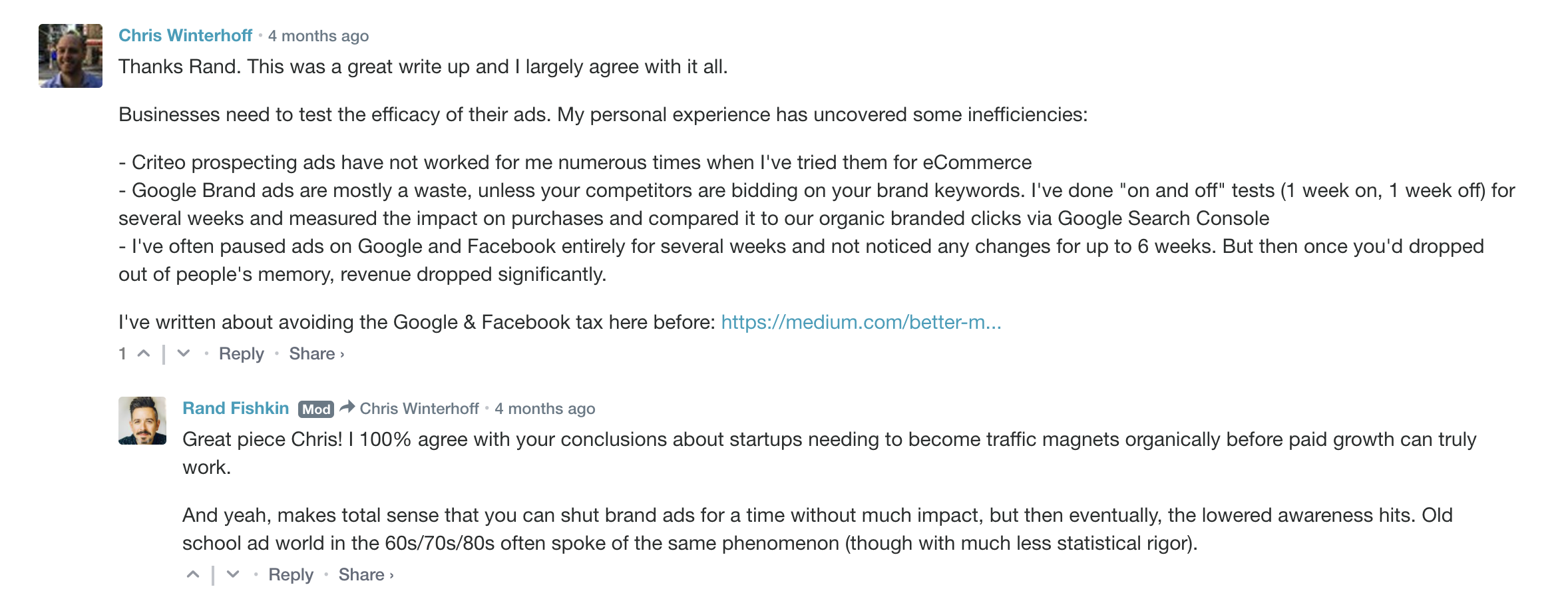
2. Engage in their social media
Follow your target bloggers on social media, leave relevant comments under their posts, share the best content with your audience, and learn about their interests.
By doing this, you’ll be able to get noticed and collect some valuable information that will help you do highly personalized outreach.
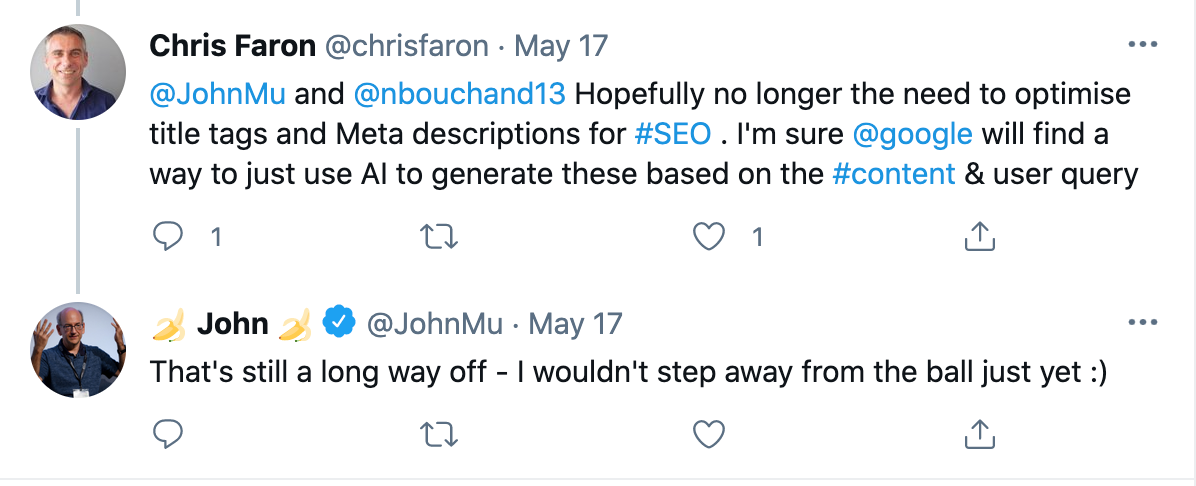
3. Make a first contact asking for nothing in exchange
You can make the first contact with a blogger asking nothing in exchange.
For example, try sharing feedback about their work (if you find it useful, don’t hesitate to share a few nice words) or include a few tips based on your own experience that can supplement their content.
If you find any typos in a blog post, you can also let bloggers know about it.

6. How to craft your pitch
For successful blogger outreach, you need a pitch that will make bloggers say "yes" to you. Here's how to create one.
1. Create a personalized and short subject line
Make your subject line personal. Besides mentioning the first name and company name in a subject line, try to think of other common ground you may have with your prospect.
For example, mutual connections, the place you met, a conference they attended, etc.
Adding a personal touch is your best bet in getting engagement for your cold emails.
Keep your subject line short. It’s much easier to catch a prospect's attention with something short, sweet, and straight to the point. Short subject lines also invoke curiosity.
2. Create personalized email copy
Personalization is crucial when it comes to sending a successful cold email. The more personal your cold email is, the better your response rate will be.
Generally, there are two key ways to personalize cold emails:
1. If you only send a few cold emails
It makes sense to spend time on high-value prospects and manually add a personal touch to every email you send.
You can create a single template for the outreach, but add precise information for each of your prospects to make the message relevant to them and provide maximum value.
2. If you send a large volume of cold emails
You can personalize your cold email outreach at scale using Campaigns. You’ll just need to add your data (in .CSV or .TXT format) to Campaigns and create a cold email campaign.
Here's how to do it:
Log in to Hunter, and go to the Campaigns tab. Once there, click the +New campaign button.
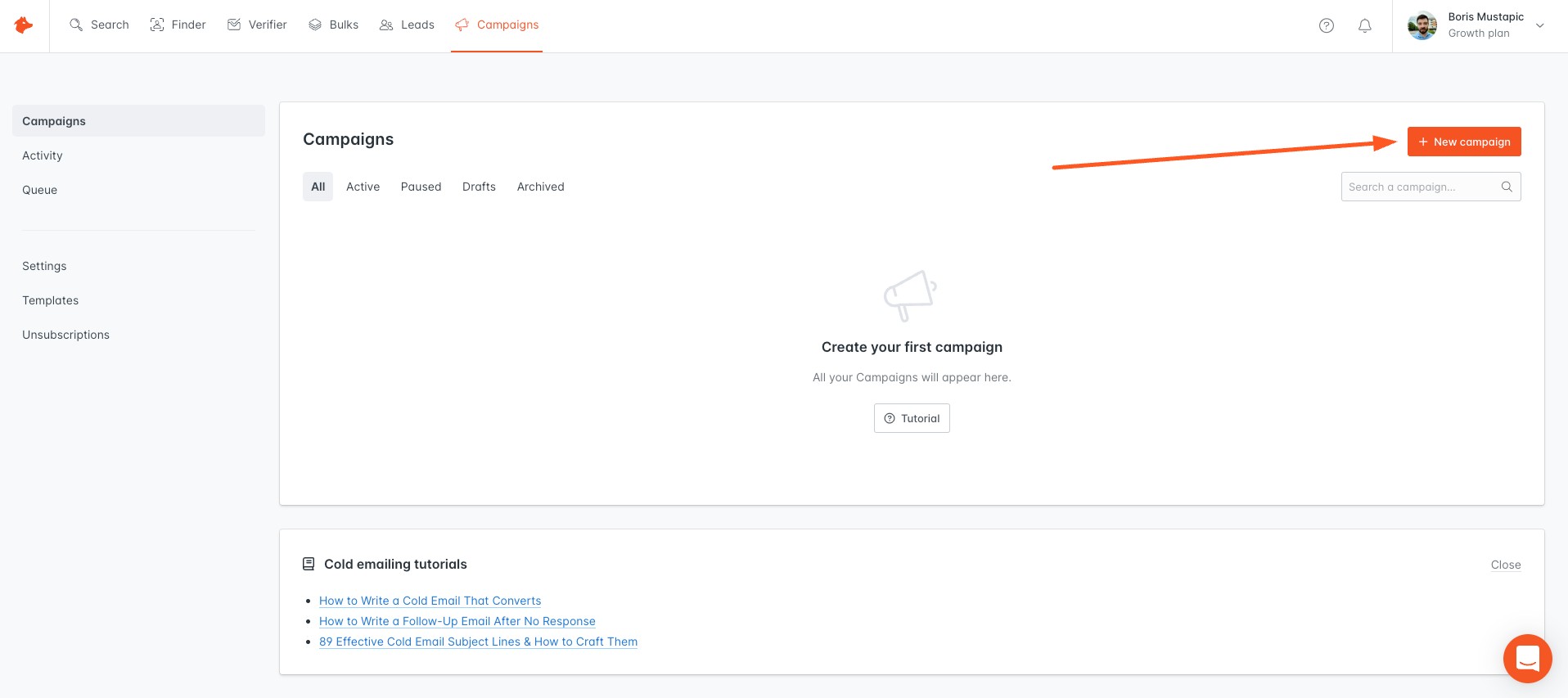
Add a subject line and email body for your email. You can then personalize the email using attributes.
Click the {}Insert attribute button and choose from the list of built-in attributes.

You can also set up additional custom attributes by going to Leads > Custom attributes.
3. Be brief and straight to the point
There are three key elements your cold email should contain:
- Who you are
- What your offer is
- The action you want the prospect to take
As long as you have these three elements in your email, you really don't need anything else.
Try to eliminate unnecessary information, don’t use wordy sentences, and be straight to the point.
Remember, most emails are read on mobile devices. It’s much easier to consume and reply to a brief message than scroll through a short story.
4. Avoid being fake
I often receive cold emails starting with “I’m a big fan of your work/content/blog,” and then the irrelevant pitch comes. That shows me that the person didn’t even do basic research before sending the cold email.
It’s so easy to spot when people are fake with their pitches!
It’s important to give honest and sincere appreciation if you want to build great relationships and stand out above everyone else.
Being honest is vital in cold outreach. People love compliments about their work, but you should know and enjoy what they’re doing.
I’m a big fan of Ahrefs, I use it daily, and it helps us automate many things related to SEO at Hunter.
When we launched our new product that is very relevant to the Ahrefs audience, I reached out to their Head of Content, Joshua Hardwick, sharing some information about the product and a few words on how I love Ahrefs.
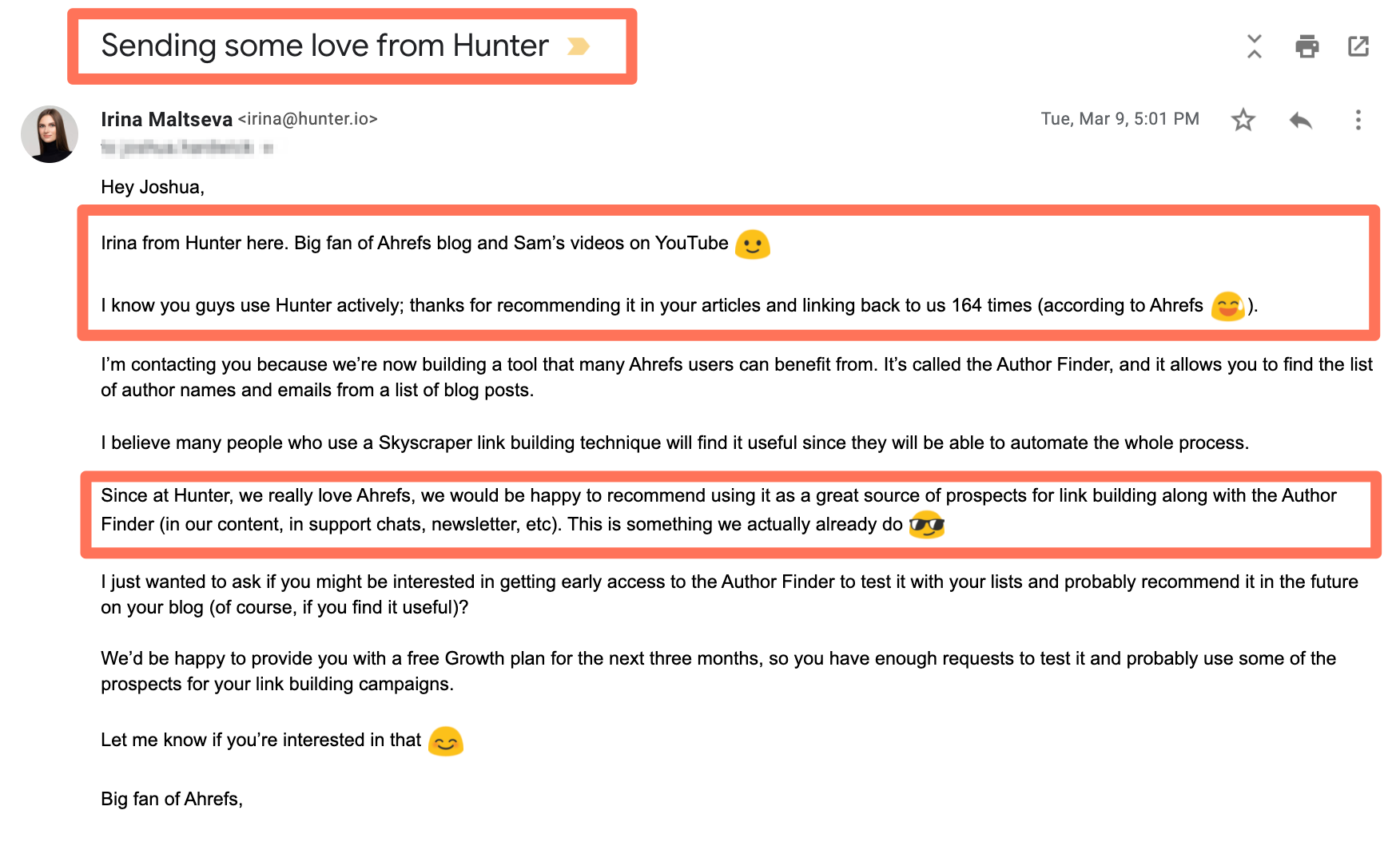
5. End with a CTA
Using the right call-to-action (CTA) is the key to boosting your reply rates. This is the part of your cold email that persuades prospects to take action—send a reply, click the link, submit a form, etc.
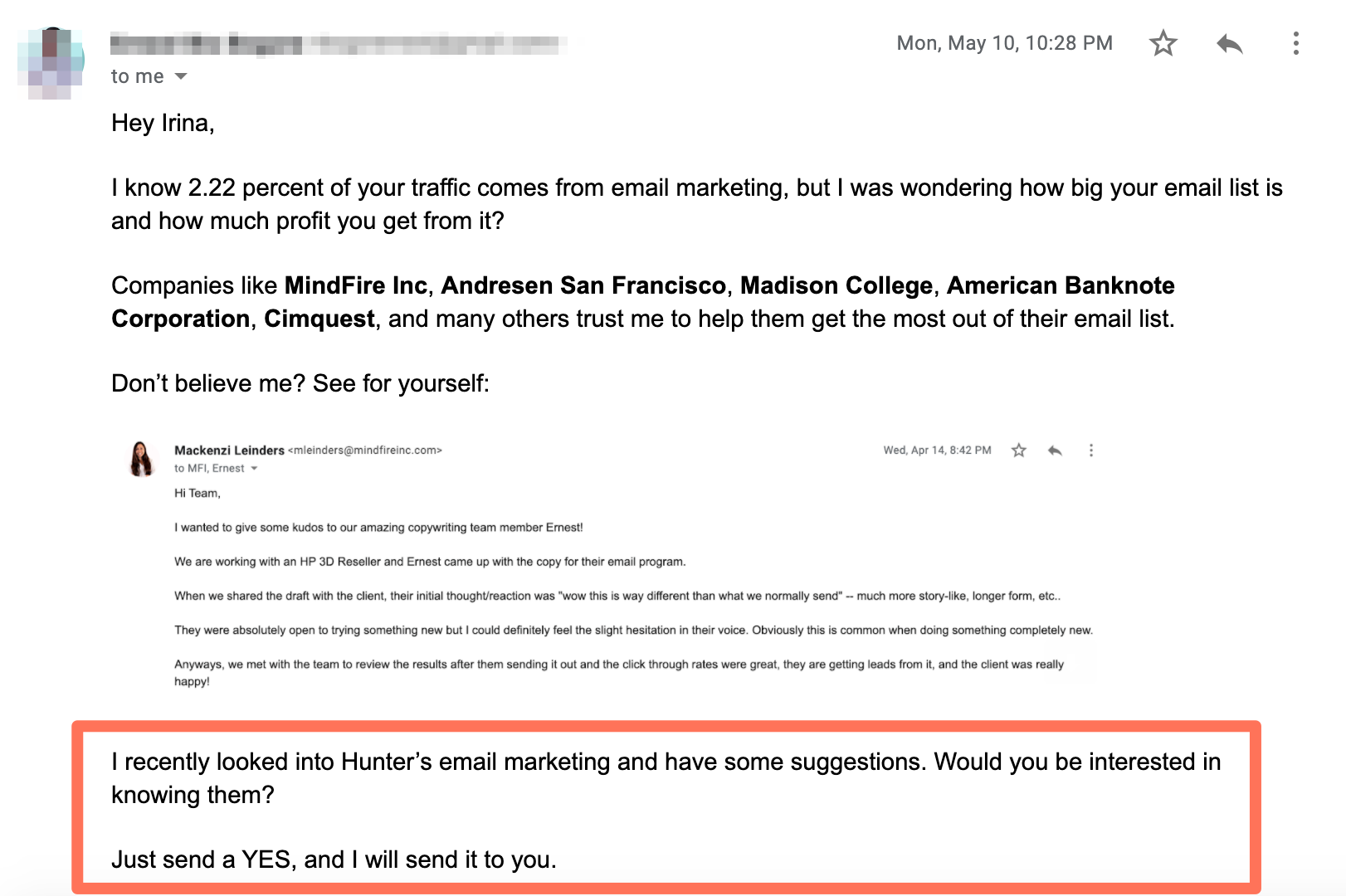
The CTA should align perfectly with the goal of your cold email. Try to focus on a single thing you want to achieve with your outreach.
Also, try to be precise and specific with your CTA and let prospects know what “next step” you expect from them to continue the conversation.
Are you looking for inspiration for your next cold email? Check out Hunter Templates - the largest free directory of cold email templates.
6. Avoid common mistakes
There are a few things I don’t recommend doing while doing blogger outreach:
- Don’t use generic templates used by everyone. Templates are great to get some inspiration and ideas for your cold outreach, but don’t copy the exact text and hit the “Send” button right away. Try to add some personalization, introduce yourself, or add something unique.
- Don’t send time-consuming requests. With cold emails, you can start with a simple ask and a straightforward CTA. Ask for something small and simple—that’s a great way to initiate a conversation with a blogger.
- Don’t be too generic. If it’s possible to find personal information about your prospect - do it! I always ignore emails starting with “Dear Madam/Dear Webmaster,” etc. It’s just as easy to find my name as an email address on the web (well, even if you don’t have time to research the name, the email says for itself, “irina@hunter.io”).
- Focus on quality, not quantity. It’s always better to add a personal touch to each email and send fewer rather than sending 10X more generic emails. It’s your best bet to build long-term relationships with bloggers and get what you want.
- Accept “no” for an answer. No means no—don’t be too pushy and ruin your relationships with bloggers entirely.
8. Track open rates
You sent your pitch to the blogger and are waiting for a reply. You’re not sure if your emails were read, got into the junk folder, or were just ignored.
The easiest way to know whether your email was open and read is to use email tracking tools. Depending on the outreach approach you’re using, your toolset may vary:
Email tracking for the sniper approach
You can use Hunter's free email tracking Chrome extension, MailTracker, which allows you to know when recipients open your emails.
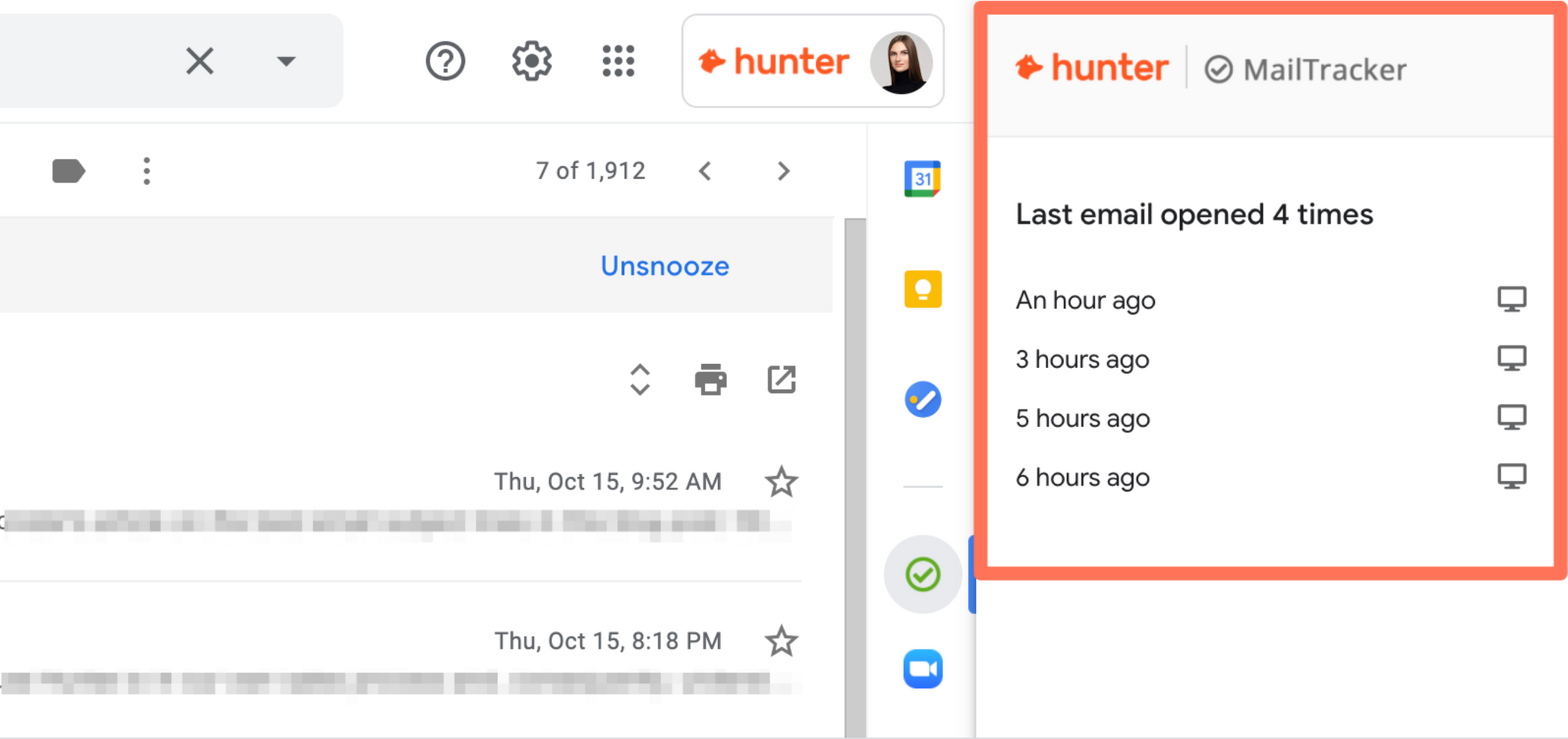
Email tracking for the shotgun approach
If you’re sending emails in bulk with Hunter Campaigns, you can check the Stats section to get detailed reports on your open rate, click-through rate, and response rate.
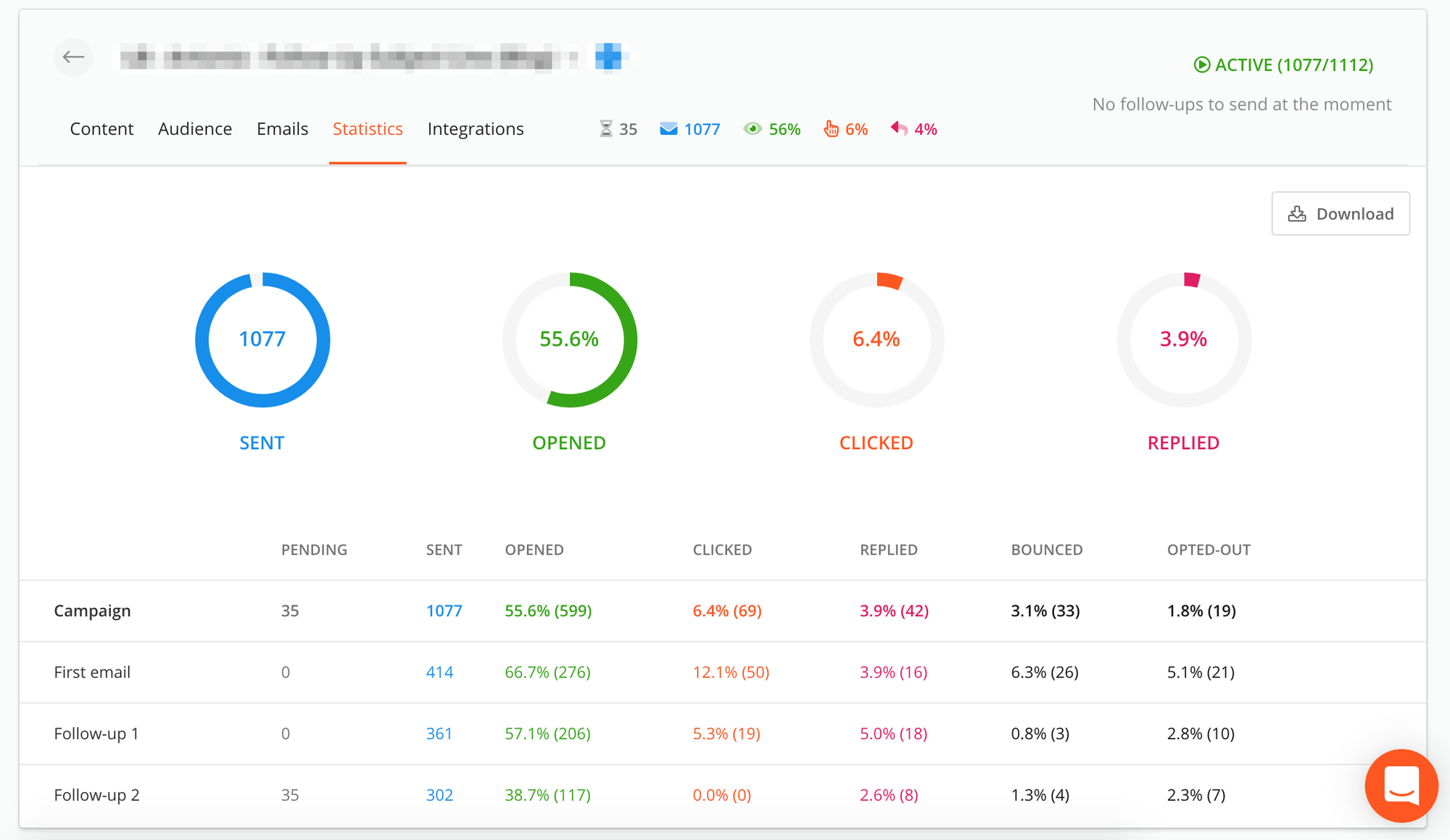
9. Send follow-ups
As research shows, you can double your response rate by sending multiple follow-up emails to prospects.
A follow-up can be another chance to pitch your product or service to the blogger, and I highly recommend that you don't miss this opportunity.
There are situations when prospects are busy or just forget to respond to the first email. It’s likely that your initial offer wasn’t clear enough to proceed, so you have another chance to explain.
How many follow-ups to send?
It’s better to focus on writing irresistible emails instead of adding too many follow-ups. So I recommend limiting to three follow-ups for your cold email campaigns.
If you send too many follow-ups to someone who’s never heard about you, you may seem like an annoying person and damage your company brand.
How often to send follow-ups?
75% of emails are opened within the first hour of being received. It's a similar situation with replies—the chances that your prospects get back to you the same day your campaign was sent are much higher.
So don’t wait for too long to send your follow-up email. Typically, 2 to 5 days is an adequate amount of time to wait before following up.
How to automate follow-up sending?
You can use Campaigns to run your follow-ups on autopilot. You can choose how many follow-ups you want to send, specify the time delays between each follow-up, personalize the subject line, and work on the email copy.
Once you set this up, you’ll never have to worry about forgetting to send a follow-up to your prospects. Everything will be sent automatically.
Wrap up
If you’re just starting out with blogger outreach, always keep in mind these two strategies: focus on building long-term relationships with bloggers and offer win-win collaborations.
Being personal, human, and relevant are the small things that will improve the results of any outreach campaign.




 Send cold emails with Hunter
Send cold emails with Hunter